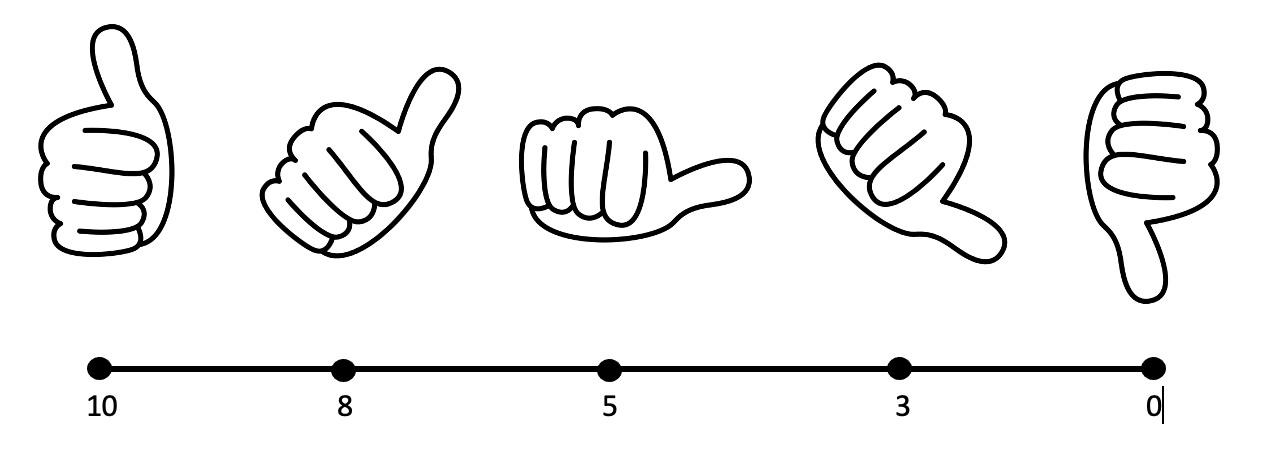|
(About a 5-minute read.)
If you've been around the team building world I'm sure you've used various thumb gauges. A simple 'thumbs up' gets a lot of use (hopefully more than the thumbs down). I frequently use (and share) two thumb gauges with my groups - they are TOOLS to transmit information quickly. One is Thumb Voting and the other is the Thumbometer.
Thumb Voting
I learned Thumb Voting from my friend Tom Leahy. He uses it as a 'Consensus-Building' tool. When faced with a decision where consensus is desired (meaning everyone agrees to something at some level), groups can use this tool to quickly see everyone’s position on a proposed decision. For example: A group works together before a particular challenge to come up with a plan. When a plan seems to be formulated, someone verbalizes the plan to all group members. Then (knowing about the Thumb Vote tool), they take a Thump Vote - everyone votes at the same time with one thumb so everyone can see. A thumbs up indicates the person understands the plan and is ready to support the plan. A thumb to the side means the person may not be completely clear about the plan but is ready and willing to do their part and figure out how to help as they go. A thumbs down indicates the person needs some clarity about the plan in order to understand what's going to happen and how they can be a part of the group's success. In other words, this person has a question (or two) about the plan. (Note: I use this tool with groups who possess some average communication skills - willing to let everyone share information and willing to listen to each other. If used too early, Thumb Voting can be used by someone to hold the group 'hostage' by using a thumbs down vote to indicate they don't like the plan and they want their own plan put in place.) In most cases, Thumb Voting is a quick way to 'see' who has questions and then answer the questions in a way to help the group move forward. Using our example above, after someone asks a question the plan might change. Then another Thumb Vote is needed to see if everyone is on board, at some level of consensus, before implementing the plan.
Thumbometer
The Thumbometer tool is used to gauge how much someone liked (or likes) something or how much someone valued (or values) something. After I show my participants what the Thumbometer scale is ("10" is a thumbs up, "0" is thumbs down, and the other numbers in between) here are some questions I might ask using the Thumbometer: On a scale of Zero to 10, 10 being the highest score...
As a way to enhance understanding and group improvement you can follow up with this question: If you're not at a 10, what would you like to see from the group in order to bump your score up one point? We find out where people are at and then determine where they want to go. Thumb Gauges are quick ways you and your group can check in with each other in order to determine next steps. What other Thumb Gauges are out there? Leave us a Comment below. I could use your help spreading the knowledge. If you know someone who could benefit from OnTeamBuilding information, please forward them this email. Thank You! All the best, Chris Cavert, Ed.D.
P.S. Would you like a super-quick update when new OnTeamBuilding content is posted? Just fill out the form below and then click the big blue button. I'll keep you posted.
0 Comments
(About a 15-minute read. This is a migration and updated post. It was first shared at the FUNdoing.com Blog. We are moving theoretical posts to OnTeamBuidling in an effort to organize content. Thanks for being here!)
The following conversation about muting participants was initiated by my friend (and fellow team builder), Floyd. He is a deep thinker so I love picking his brain.
Floyd: I'd like to take some time and delve deeper into a topic I've been thinking about and see if I can't get some thoughts from more experienced folks I trust and respect. It is about muting people who speak the most or the loudest in a community. If you are up to it, I would love to get your input. Often when I see facilitators muting individuals it is with hope that the people who don't speak up as much will have their voices heard by the folks that talk a lot, and the ones who talk a lot will develop skills in listening and communicating in new ways. Do you have thoughts on this topic, or ways you have used it as a tool?
Chris: Thanks for reaching out Floyd! First, I agree with your initial assertion. I too believe, in most cases, people are muted by the facilitator with the "hope that the people who don't speak up as much will have their voices heard by folks that talk a lot." (I wonder, where a group would be if they muted the talk-to-muchers? And what would this look like in a safe environment?)
So, we both agree that the hope is others will speak up. Now, as we ultimately find out, muting someone (or more than someone), does not guarantee others will speak up. (We could start with the whole extrovert/introvert dynamics here as just one reason why.) So, as an educative practice, it's not the best tool to use to get others to speak up more. However, when you are newer to facilitation muting can be an introductory tool. And, you never know. I'm sure there are success stories after implementing the basic mute. To this day, I still threaten to mute when it seems like a "heads up" might nudge the group (or particular person) into a way of behaving (e.g., listening more). I will say something like this: "You know Steve, I noticing the muting bees have started circling you. They are attracted to a lot of sentences strung together by one person. If you happened to get stung by one of these bees I'll let you know. The bee toxin will swell up your vocal cords for a certain amount of time. I would hate for this to happen - just wanted you to know."
Most of the time this light-hearted information gets the point across in that moment.
Let's go to the second assertion you mentioned, "...and the ones who talk a lot will develop skills in listening and communicating in new ways." Here's my reaction to this. If someone is talking so much that you must mute them so that others in the group can get some space to talk, it is "inconceivable" (to quote my favorite movie) that this person will make the leap to changing their behavior to be a better listener or communicator. It is more likely, when muted (if they stay muted) that they are simply formulating and rehearsing what they will say when they get the chance to talk again. Now, my response (after some thinking) to this assertion. If a facilitator uses the muting tool, on purpose, to encourage better listening and better communication behaviors it would be educationally prudent to frontload the expectation. Here's what I would say: "If I end up muting you during the activity, meaning you cannot talk, it does not mean you did anything wrong. It simply means I would like you to turn on your listening behaviors and soak up the information that fills the room while you're muted. Combine the information you hear with the information you have in your head about the situation. Blend this up and see what you get. When you are ready to jump in and verbally share with the group again, go right ahead." I see this way of muting as specifically inviting someone to experience a particular behavior - listening - at a specific time. Also, when I use this tool I don't use it only with the over-talkers. I use it with different people over a progression of activities. Then, we have another talking point to bring up during the processing experience. "What was it like for you going into listening mode after I muted you? Was there any benefit to you or the group when you went into listening mode?" Why do I mute in this way? When I share my process and say you have done nothing wrong, it (tends) to reduce the defensiveness from participants. They are not embarrassed after being muted (in most cases!) it is simply a part of the experience. The group knows someone in the group is practicing a particular behavior and are often very supportive. As an educator, I want to encourage (and sometimes require) a certain behavior, letting the student practice to see how it works for them.
Floyd: Thanks for getting back to me Chris! First, to answer some of your questions, I am a long-time user (abuser) of the mute tool. A few years ago, however, I was placed in a position in a group where I was the only one not muted. This was a facilitator training at a course in the Midwest I had no experience with, but training as a contractor. The lead facilitator knew I had a lot of facilitation experience. The rest of the community I was working with knew each other (worked together in a residential treatment facility), but were unaware of my experience. As the day progressed, I realized that the lead was using a lot of "one right answer" methods and activities but, instead of encouraging an answer collaboratively devised by the community, he kept looking for me to "speak up" and solve the challenge. Finally as the group was working to come up with [their] answer to an activity, he muted everyone except me and expected that I would then bring the group to a good answer. This on-the-spot feeling has since then challenged my philosophy on its use.
Currently I use muting in a general way. I offer it as the consequence for stepping in the muting river, or as the theme of one of the islands on a triangle tension traverse, or use a half-blind half-mute twist to a challenge adding some unique dynamics. I have, however, stopped using muting on the loud ones. My hope with discontinuing the practice is that I can come up with something that offers groups some tools when they leave. I have come close to something I like, but it certainly needs to be refined. That is, I use an activity as a sort of pathways or grid. We get to the initiative and I will introduce safety concerns that must be addressed during the challenge, but it is up to the group to figure out how to complete the challenge, and by the end, they know all or as many of the rules of the activity as they can figure out. As they experiment with things I will let them know when they have done something outside of the rules of play. So far I have had some good success with this and have noticed that the [talkers] might start out speaking loudly, but when the rules are nothing like they expected, they have to rely on listening to other people for ideas to experiment with, and as the community starts running out of solutions they then find themselves asking the quiet ones to speak up. As an introvert myself, I’ve noticed this invitation from my peers is often what motivates us [me] to share ideas. These ideas might still not be the solution, but everyone sharing and being heard, and everyone experimenting with ideas always gets people further. Again, needs to be refined, but something I am using in place of the mute. Much more to the point, I stopped using the mute because I feel communities are performing at a level they reached through storming and norming in their every-day environment in one way or another. When I mute a person I feel like your description is exactly what happens. That person is not likely to spend time listening (if they stay muted at all), but instead, will be trying to figure out what to say when they get a chance, or how to communicate their idea above all else happening in the group anyway. When they go back to their community environment, the loud ones will continue to be loud and heard, the ones with perceived power will continue to have the perceived power, and the quiet ones will continue to keep their ideas to themselves.
This takes me back to my years working with kids. We would take kids out of the pool to teach them lessons about behaving in the pool. In my experience, I have not seen either strategy work. It is not my responsibility as an educator to remove the challenges or to remove members from the challenge while I'm working with communities. My responsibility is to help the community identify problem areas occurring in their community, and then work with them to come up with actionable solutions they can use back in their own environment.
I agree with you that muting can be a tool for new educators. My hope for these types of tools for facilitators is just as everything with facilitation; That they will be considered often, and from other points of view. (Today I may not like using the mute, but in conversations with others I am shown that it is a useful tool when we know why and how to use it). I used to work with a fellow that challenged me daily to know why I did what I did, how it affected the group, if the group walked away with the outcomes they were looking for and then some, and to find new ways to interact with groups and initiatives. This has been paramount to my growth as a facilitator. While I know this is the environment with many experiential programs, I know, and have worked in those situations, where those early tools just become the rule, and no one really knows why. I like your ideas about offering muting and listening as tools to the group. I want to write "LISTEN" on a polyspot, and frontload it at the beginning of the day: "If anyone is feeling like they are talking too much, or if anyone has been unable to hear the rest of the community, you are welcome to stand on this LISTENING spot for as long as it takes to reach the goal you are looking for. If, as a member of this community, you need to support someone else by encouraging them to use the listening spot for some reason, please feel free to offer this resource."
Likewise, if someone is feeling like they aren't being heard, or feel like someone's idea isn't being heard, this spot can be used here as well. The person can use the resource as a way of getting the attention of the group to share their ideas. While in the experience you can then process through why a community would need such a resource, and what this resource could look like back in the community environment. Man, I really like the LISTENING spot! I can see so many opportunities for communities to take advantage of this.
I fear I have grown long winded here, and running all these sentences together may be causing the muting bees to get to buzzing! Thanks again for your time!
(Chris here...) What a journey! Floyd loves to build dendrites. Where do you sit with the idea of muting? How have your experiences been with this tool? Leave us a Comment below.
All the best, Chris & Floyd Podcast Listeners, interested in the topic of consequences? Check out Using Consequences During Team Building Activities at the "Ask Michelle & Chris About Team Building" podcast. Want to build more dendrites with Floyd, listen to my OnTeamBuilding Podcast Interview with Floyd.
P.S. Would you like a super-quick update when new OnTeamBuilding content is posted? Just fill out the form below and then click the big blue button. I'll keep you posted.
|
OnTeamBuilding is a forum for like-minded people to share ideas and experiences related to team building. FREE Team Building
Activity Resources OTB FacilitatorDr. Chris Cavert is an educator, author and trainer. His passion is helping team builders learn and grow. Archives
January 2024
|





 RSS Feed
RSS Feed